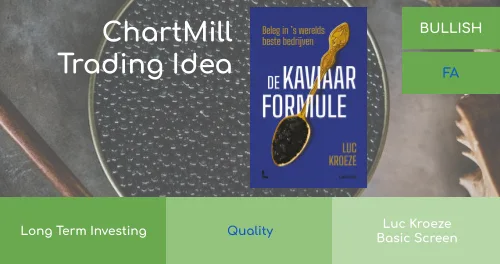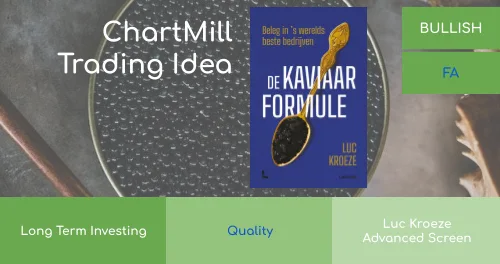Caviar Cruise – A Stock Screener for Quality Investing
By Kristoff De Turck - reviewed by Aldwin Keppens
Last update: Apr 19, 2024
The Caviar Cruise screen is a screen dedicated to Quality Investing. While both Caviar and Cruises are associated with richness and wealth, we mainly used this name to pay tribute to a Belgian author Luc Kroeze, who’s book (The Caviar Formula) was used as inspiration for this screen. Unfortunately the book is only available in Dutch. We also thank the author for reviewing and fine tuning our screens.
Even more than pure value investors, quality investors are using a buy-and-hold strategy. Quality investing is about selecting the best companies globally and becoming an owner of them for a (very) long time if not forever. Of course, before you decide to buy a stock which you want to hold forever, some decent research will be needed and unfortunately not all criteria for quality investments are easily and objectively quantifiable. But still, many criteria are quantifiable and a stock screener can help you compose a list of companies you want to understand better and investigate further.
In this article we will discuss the settings of a screen finding quality stocks as well as why the filter is used. The screen is actually split up into 2 screens: a base screen, with basic filters which already provide interesting companies and a more strict screen, which builds upon the base, but tightens the criteria a bit. At the end of the article we will also discuss some of the less quantifiable properties a quality investor should consider.
Quality Stock Screener filters – basic version
In this section we will go over the filters of the basic Caviar Cruise screen and explain their purpose.
Revenue-growth (5Y CAGR) > 5%
The primary measure of historical performance is revenue growth (the total number of goods and/or services sold in a given period multiplied by the selling price). Only stocks that can show an annual sales growth of at least 5% are included.
EBIT growth (5Y CAGR) > 5%
In addition to revenue growth, profit growth is also taken into consideration. To estimate this profit growth it is important to look at the right figures.
- The gross profit gives a picture of what remains of the profit after all costs, related to the product, are deducted.
- The operating profit (EBIT - earnings before interest and tax) is obtained by including all operating costs such as wages, rent, depreciation and development and/or marketing costs.
- Finally, to arrive at net profit, taxes and other financial liabilities are also taken into account. When the net profit is divided by the number of shares outstanding you obtain the EPS.
The author points out that while gross profit says something about profitability, it says nothing about the cost of doing business itself and whether or not it is done efficiently.
Net profit, on the other hand, makes it difficult to compare companies (globally). Depending on the type of industry or sector to which the company belongs, the capital structure is quite different and, in addition, different tax rules apply in different countries.
So ideally we look at EBIT growth to compare companies in their core operational activity. We use the EBIT growth filter and determine that growth should be at least 5% annually. Select “EBIT Growth 5Y at least 5%”
EBIT growth (5Y CAGR) > Revenue-growth (5Y CAGR)
We want our quality company to have shown a nice and stable growth in the past 5 years. We want at least 5% revenue and ebit growth, but we also want to make sure the EBIT is growing more than the revenue, which indicates improving profitability. Firms that succeed in this are likely to enjoy economies of scale or they have pricing power that should not be underestimated.
We also make a note here that pure EBIT growth is the best way to ensure core operations are expanding. EPS growth can give a wrong impression because it can be offset, for instance by non recurring items, by reducing the number of shares or new tax rules.
ROICexgc > 15%
We want a return on invested capital of at least 15%. ROIC is one of the (if not the) most important criteria when looking for quality stocks. The ROIC measures to what extend the allocated capital (investments) are put to work and lead to profits. As this is one of the key metric, the results of the screen are also sorted by ROIC by default. We are using the variant of the ROIC where the return is calculated on the core invested capital, so excluding cash, goodwill and intagibles.
The screener allows you to use the ROIC based on three variants, why that matters can be read in this article.
Debt / FCF < 5
In order to get a good picture of the debt position and estimate to what extent the debts are effectively manageable, the following filter compares the debt to the free cash flow.
Free cash flow is the portion of cash that can be taken out of a company each year after all costs, liabilities and investments have been dealt with. That money can then be used to pay dividends to shareholders or to buy back shares, for example. Alternatively, that money can be used to finance acquisitions or pay off debt (faster).
This ratio shows how many years it will take to repay all outstanding debts with the current free cash flow.
0 to 5 years is a good acceptable ratio for quality companies, a higher figure indicates some danger and ensures that you will have to dig further into the numbers to find out what the exact cause is.
Profit Quality (5y average) > 75%
The Profit Quality is defined as the Free Cash Flow to Net Income as a percentage and expresses to what extend the company is able to turn net profit (an accounting number) into real hard and valuable cash. When all of the net profit booked is turned into free cash flow we can consider the profit being of high quality. So ideally we would like to see 100% of net income turned into free cash flow, but it does not need to be a problem when this is not always possible. This is why we set this filter to at least 75% on average over the last 5 years.
One very good reason for the Profit Quality to be below 100% is when the company reinvests a bigger portion of the income. By including this filter we are actually looking for companies which are already more mature and do not reinvest the entire profits. If you do want to search for such companies this filter should be removed.
When you have a Profit Quality below 100%, you can use the CapEx to Depreciation ratio to check whether reinvestment is going on. The CapEx to Depreciation ratio will compare the CapEx (Capital Expenditures) to the Depreciation. ‘Capital Expenditures’ is what the company invests during the current year to keep the business operational. ‘Depreciation’ is the amount which is not a real cash expense, but can be subtracted from profits in the bookkeeping and is based on investments made in the past years. So we can say that the Capital Expenditures of today are the Depreciation of the future. When the Capital Expenditures exceed Depreciation, we can conclude that the company is investing more today than it did in the past and it is doing more than just keeping the business going: it is investing in expansion and future growth. This is why we like to see this number above 100%.
Note: the ROIC, Profit Quality and Capex to Depreciation have some relation and should be considered together. We like so see a company turn the full amount of net profit into free cash flow. But, when the CapEx exceeds the depreciation, there is a pretty good chance that the free cash flow will be below net income. This is ok, as we need the company to invest in growth, so we will not require the 100% net profit into free cash flow ratio for our screen. Certainly because we also take into account the high return on the invested capital, the company has all the properties required for a quality investor.
Additional Quality Stock Screener filters – strict version (Advanced Screen)
OM growth 5y > 0% | PM growth 5y > 0% | ROIC 5 year growth > 0%
We want the profitability of the company to improve or grow over time. This is an indication of pricing power and competitive advantages, as well as good management of the business in general. These 3 filters are all in the same area: we want the Profit Margin, Operating Margin and ROIC to have increased over the past 5 years. These filters imply that more of the revenue flows into Operating and Net Profit and we have an increasing return on invested capital.
Future revenue growth (3y)> 5%
Not only should the company have had increasing revenue in the past, we also need analysts to expect further growth in the future, indicating the business is still expanding.
Tip: these additional filters reduce the list from the base screen drastically. It may be interesting companies are dropped from the list. You can investigate which companies drop off by adding the inverse filter to the base screen. For instance: starting from the base screen and adding the condition ‘OM growth 5 year < 0’ will show you only the companies that will be dropped from the list when you add the requirement for Operating Margin Growth. Sometimes filters are unfair: when for instance the starting year of the comparison was an exceptional year, the current value may be lower, but underlying a stable growing trend could be hidden.
Valuation
A quality investor will not ignore valuation, but is also not looking for undervalued stocks as such. Quality has a price and the quality investor is willing to pay a fair price, but at the same time does not want to become an owner at any cost. We did not use any valuation filters in these screens, but we are highlighting here that an evaluation of the valuation should be done before deciding to buy or not.
Other Quality Investing Criteria
When evaluating whether a company qualifies as a quality investing candidate, we also evaluate whether the company:
- is growing because of an underlying existing and long term trend.
- has a competitive advantage.
- is active worldwide.
- is easy to understand.
- has a capable management.
- has the ability to set their prices.
- is not or only partially affected by a recession.








